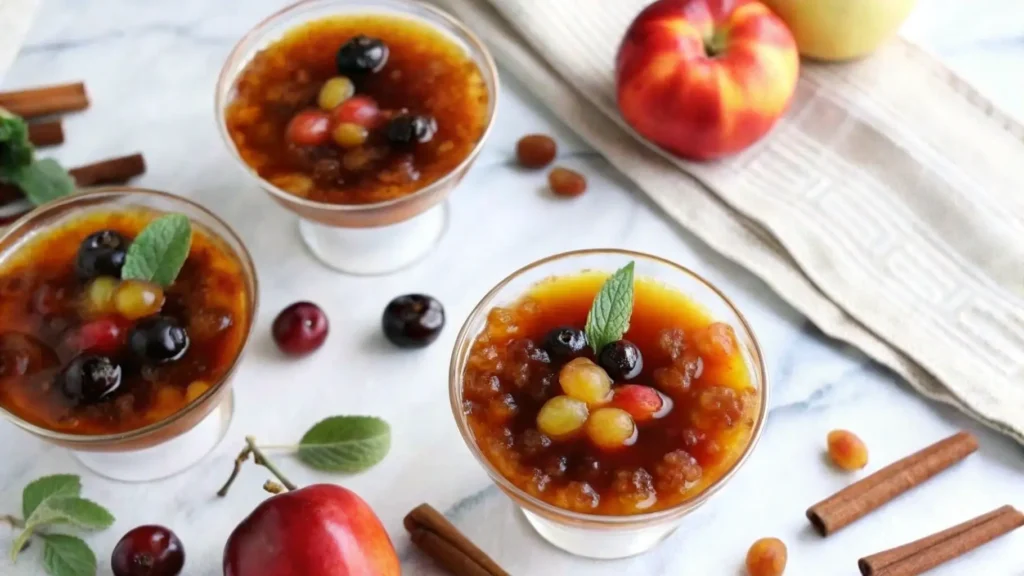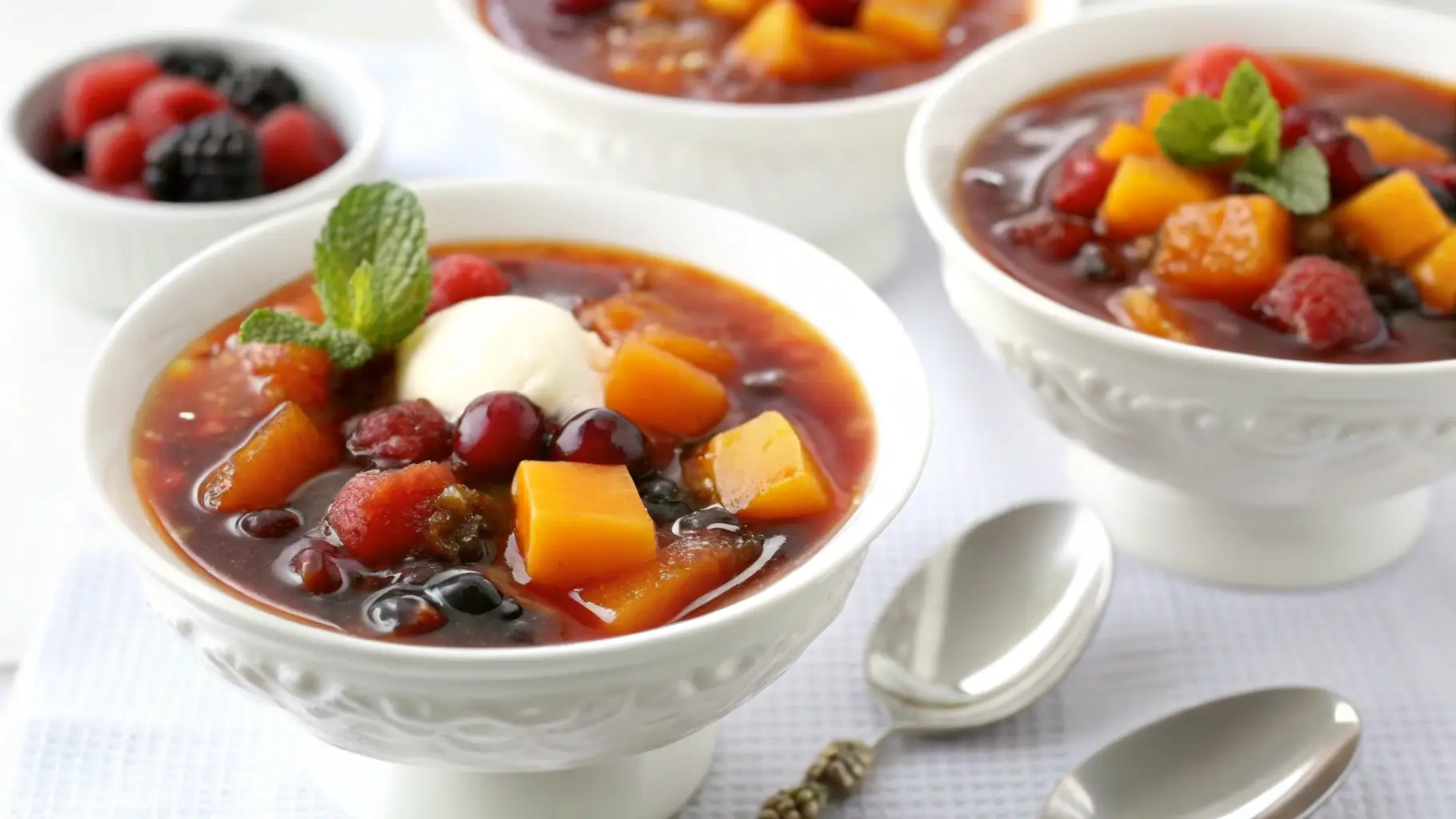Fruit Suedoise Recipe: A Guide to Swedish Fruit Soup
Swedish Fruit Soup, known as Fruit Suedoise, is a delightful Scandinavian dish beloved for its sweet and tangy flavors. Traditionally served warm or cold, this soup blends dried fruits, spices, and a hint of sweetness to create a comforting dish enjoyed year-round. In this article, we’ll dive into its rich history, unique ingredients, and cultural significance before guiding you through the recipe preparation.
What Makes Fruit Suedoise Unique in Scandinavian Cuisine?
Fruit Suedoise stands out in Scandinavian cuisine for its versatility and simplicity. While much of Swedish cooking emphasizes hearty flavors—think meatballs and gravlax—this dish offers a sweet, light alternative. It’s commonly served during winter holidays but can easily adapt to summer menus with the use of fresh fruits.
A Brief History of Swedish Fruit Soup
The origins of Swedish Fruit Soup trace back to the need for practical, long-lasting dishes. Dried fruits, a staple in Nordic pantries, provided essential nutrients during harsh winters when fresh produce was scarce. Over time, the soup evolved to include spices like cinnamon and cloves, showcasing global influences brought by trade.
Seasonal Traditions Around Fruit Suedoise in Sweden
In Sweden, Fruit Suedoise often graces the table during festive seasons. During Christmas, it is served as part of the traditional smorgasbord, offering a refreshing balance to heavier dishes. It’s also popular during midsummer celebrations, where fresh berries and fruits are used for a seasonal twist.
Why Swedish Fruit Soup Is Loved Globally
Health Benefits of a Fruit-Based Dish
One reason Fruit Suedoise enjoys global appeal is its health benefits. Made primarily from dried and fresh fruits, this dish is rich in fiber, vitamins, and natural sugars, making it a healthier dessert option. Spices like cinnamon and cloves not only enhance flavor but also offer anti-inflammatory properties.
The Role of Dried Fruits and Spices in the Recipe
Key ingredients include:
- Prunes: For their rich, sweet flavor.
- Apricots: Adding a tangy note.
- Raisins: Providing texture and sweetness.
- Spices: Cinnamon, cloves, and nutmeg elevate the dish with warm, aromatic undertones.
Modern Adaptations and Variations
While the traditional recipe remains a favorite, modern adaptations often incorporate:
- Fresh fruits like apples and berries for a seasonal touch.
- Substitutes like agave syrup or coconut sugar for a healthier twist.
When to Serve Swedish Fruit Soup
Everyday Meals, Holidays, and Special Occasions
Fruit Suedoise’s versatility means it can be:
- A light breakfast or snack, served with yogurt.
- A dessert after a hearty Nordic meal.
- A festive treat, served warm during Christmas with cream.
This dish is perfect for any time of the year, making it a must-try for anyone exploring Scandinavian cuisine.
How to Make Swedish Fruit Soup: A Complete Guide
Welcome to Part 2 of our journey into the world of Swedish Fruit Soup. Now that we’ve explored its rich history and unique role in Scandinavian cuisine, let’s get started with a step-by-step guide to creating this comforting dish. With straightforward instructions, this section will ensure you master the recipe.
Ingredients List: The Foundation of the Recipe
To begin with, gather all your ingredients. Having everything ready will make the process smooth and enjoyable.
Key Fruits: Prunes, Raisins, Apricots, and More
The heart of Swedish Fruit Soup lies in its selection of dried fruits. Here’s what you’ll need:
- Prunes (1 cup): These add depth and sweetness.
- Raisins (½ cup): For texture and a touch of chewiness.
- Dried Apricots (½ cup): Their tangy flavor balances the soup.
- Apples or Pears (1-2, fresh): These provide freshness and crunch.
Additional Ingredients: Spices, Sweeteners, and Thickening Agents
To make the soup truly flavorful, include:
- Cinnamon sticks (2 pieces): For warmth.
- Whole cloves (4-6 pieces): Adding a subtle spice.
- Nutmeg (a pinch): Enhances the aroma.
- Sugar or honey (¼ cup, adjust to taste): Sweetens the soup.
- Tapioca or cornstarch (1-2 tbsp): Thickens the mixture.
Water and Optional Add-Ins
- Water (5 cups): Acts as the base of the soup.
- Optional: Lemon zest or orange peel for added citrus notes.
Preparing the Ingredients for Cooking
Now that you have your ingredients ready, it’s time to prepare them.
Soaking Dried Fruits for Maximum Flavor
Start by soaking the dried fruits:
- Place the prunes, raisins, and apricots in a large bowl.
- Cover them with warm water and let them sit for 30 minutes. This step ensures the fruits soften and their flavors intensify.
Cutting Fresh Fruits for the Recipe
While the dried fruits soak, peel and chop fresh fruits:
- Slice apples or pears into bite-sized pieces.
- If using citrus zest, grate it finely and set aside.
Cooking the Soup: A Step-by-Step Process
Here comes the exciting part—cooking! Follow these steps closely for the perfect Fruit Suedoise.
1: Combine the Ingredients
- Pour 5 cups of water into a large pot.
- Add the soaked dried fruits, along with their soaking liquid.
- Stir in the cinnamon sticks, cloves, and nutmeg.
2: Simmer Until Tender
- Bring the mixture to a gentle boil.
- Lower the heat and let it simmer for 15-20 minutes.
- During this time, the fruits will soften and release their natural sweetness.
3: Thicken the Soup
- In a small bowl, mix tapioca or cornstarch with a few tablespoons of cold water to form a slurry.
- Slowly pour the slurry into the simmering soup, stirring constantly.
- Cook for another 5 minutes until the soup thickens slightly.
Tips for Customizing the Flavor Profile
What’s great about Swedish Fruit Soup is its flexibility. Here’s how you can tweak it to suit your taste:
Adjusting Sweetness with Sugar or Honey
- If you prefer a less sweet version, reduce the sugar or skip it altogether.
- For a richer taste, use honey or brown sugar.
Using Seasonal Fruits for Variety
- In summer, add fresh berries like raspberries or strawberries for a vibrant touch.
- In autumn, include pears and figs for a cozy twist.
Experimenting with Citrus
- A squeeze of lemon juice can brighten the flavors.
- Orange zest adds a festive feel, perfect for holidays.

Serving, Storing, and Creative Variations of Swedish Fruit Soup
Welcome to Part 3 of your Swedish Fruit Soup journey! Now that you’ve learned how to prepare this delicious dish, it’s time to explore the best ways to serve it, how to store it properly, and some creative twists you can try. With these tips, you’ll not only enjoy the traditional version but also make it your own.
Serving Swedish Fruit Soup: Presentation Tips
Once your soup is ready, you’ll want to serve it in a way that highlights its beautiful colors and flavors. Here’s how to do it:
Hot vs. Cold: The Best Ways to Serve Fruit Suedoise
First of all, consider the temperature.
- Hot Serving: During cold winter months, serve it warm as a comforting dessert. The spices like cinnamon and nutmeg are especially soothing when the soup is warm.
- Cold Serving: On the other hand, in summer, chill the soup for a refreshing treat. Cold Fruit Suedoise pairs beautifully with a dollop of whipped cream or a sprig of mint.
Traditional Garnishes and Toppings
Next, think about garnishes. These small additions can elevate your soup:
- A swirl of heavy cream for richness.
- A sprinkle of chopped nuts, such as almonds or walnuts, for texture.
- Fresh mint leaves for a pop of color.
Pairing Suggestions: What to Serve with Fruit Soup?
Then, pair the soup with complementary dishes:
- Bread or rolls: Serve it alongside warm rye bread for a balanced meal.
- Light desserts: Pair with shortbread cookies for a delightful contrast.
- Breakfast options: Add a scoop of the soup to yogurt or granola for a fruity twist.
Storing and Preserving Swedish Fruit Soup
When you’ve made a big batch of Fruit Suedoise, you’ll want to store it properly so you can enjoy it later. Fortunately, this dish keeps well if handled correctly.
Refrigeration Tips for Freshness
First, always let the soup cool to room temperature before storing it.
- Transfer it to an airtight container to prevent it from absorbing other fridge odors.
- Store it in the fridge for up to five days. Reheat it gently on the stove if serving warm.
Can You Freeze Fruit Suedoise? A Guide to Freezing
For longer storage, freezing is an excellent option:
- Pour the soup into freezer-safe containers, leaving some space at the top for expansion.
- Label the containers with the date to keep track.
- Freeze for up to three months.
When you’re ready to enjoy it, simply thaw the soup overnight in the fridge and reheat as needed. You may need to stir it to recombine the flavors.
Creative Twists on the Classic Recipe
One of the best things about Swedish Fruit Soup is its adaptability. While the traditional recipe is delightful, you can easily give it a modern twist.
Vegan and Gluten-Free Variations
First, if you’re catering to dietary preferences:
- Replace honey with maple syrup or agave for a vegan option.
- Use cornstarch instead of tapioca for gluten-free thickening.
Adding Creamy Elements: Yogurt, Cream, or Ice Cream
Second, for those who love creamy desserts:
- Serve the soup with a dollop of Greek yogurt for a tangy contrast.
- Add a scoop of vanilla ice cream to chilled soup for a decadent dessert.
- Stir in a splash of coconut milk for a tropical flair.
Incorporating Exotic Fruits for a Fusion Twist
Finally, try introducing unexpected fruits:
- Mango or papaya can bring a tropical twist.
- Kiwi adds a tart, refreshing note.
- Pomegranate seeds can serve as both a garnish and a burst of flavor.
Frequently Asked Questions About Swedish Fruit Soup
Here are answers to some common questions to ensure your recipe turns out perfectly:
- Can I use fresh fruits instead of dried ones?
Yes, but the flavor will be lighter. Fresh fruits are great for summer versions. - What if my soup is too thin?
Add a bit more tapioca or cornstarch slurry, but do it gradually to avoid over-thickening. - How can I make the soup less sweet?
Reduce the sugar or sweetener, and add a splash of lemon juice for balance. - Is it necessary to soak the dried fruits?
Soaking is highly recommended because it softens the fruits and releases their flavors. - Can I make this soup in advance?
Absolutely! In fact, the flavors improve after a day in the fridge. - What are some other spices I can use?
Try cardamom or star anise for a unique twist. - Why does my soup taste bland?
Make sure you’ve added enough spices and let the soup simmer long enough for the flavors to develop. - Can I skip the thickener?
Yes, but the soup will be more like a fruit compote. - Is this dish suitable for kids?
Definitely! The sweet and fruity flavors are often a hit with children. - What’s the best way to reheat the soup?
Use low heat on the stove to avoid overcooking the fruits.
